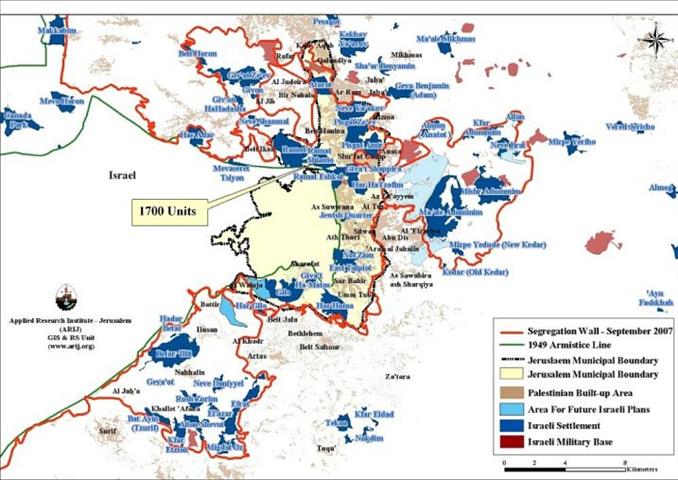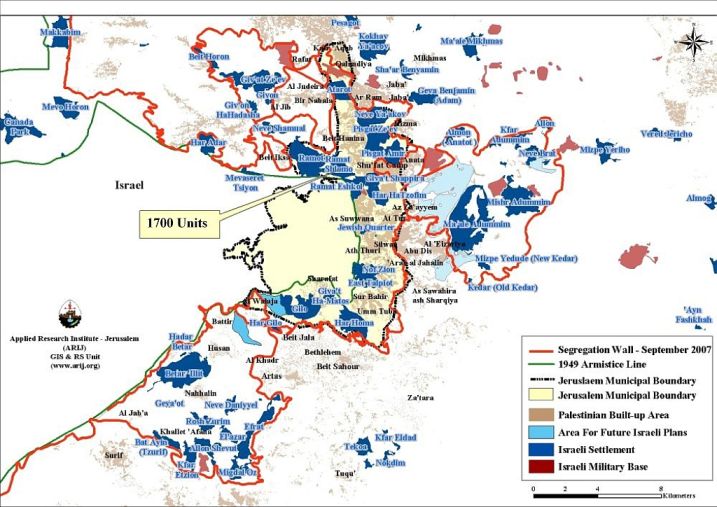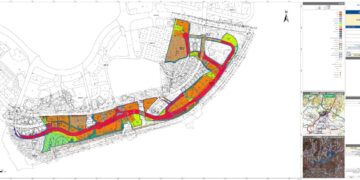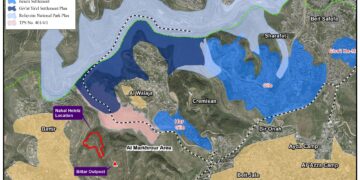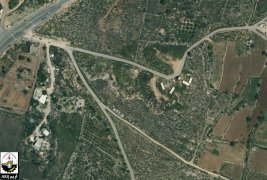The Israeli daily newspaper reported on March 19, 2014, that the Israeli Jerusalem Local Planning Committee affiliated to the Municipality of Jerusalem has given the green light to build 184 new housing units in two Israeli settlements in East Jerusalem. The targeted settlements are Har Homa (Abu Ghneim) with 144 housing units to be built in the area designated as “Har Homa C” (TPS 10310), and another 40 housing units in Pisgat Zeev settlement, (TPS 8151).
The TPS # 10310, which targets the southeastern part of the existing Har Homa settlement, was first submitted to Public review in the year 2008. The plan then has been advancing through the approval stages since the late 2010. In August 2011, the Israeli Ministry of Interior has given its final approval to the implementation of TPS 10310 which states, in the first place, the construction of 910 units in the settlement of Har Homa (Abu Ghneim), in the area planned to become as “Har Homa C”.
While TPS # 8151, targets the southeastern part of Pisgat Zeev settlement. The original plan states the construction of 233 new housing units in the settlement and was first submitted to public review in the year 2007. See Map 1
Map 1: The Israeli plans in Pisgat Zeev and Har Homa Settlements
Har Homa and Pisgat Zeev Settlements,
Har Homa settlement (known to Palestinians as 'Abu Ghneim Mountain') is located 2 kilometers to the north of Bethlehem city and 7 kilometers to the south of Jerusalem. The settlement has been built in the year 1997, on the Palestinian-owned lands of Abu Ghneim Mountain which is historically owned by the Palestinians of Bethlehem and Beit Sahour cities, as well as the villages of Um Tuba and Sur Baher in Jerusalem city. When Israel occupied East Jerusalem along with the West bank in 1967, it adopted Illegal step to redefine the boundary of East Jerusalem city in a unilateral matter. The new illegal Israeli boundary included Abu Ghneim Mountain. Today, the settlement occupies a total land area of 2262 and is house to 25000 Israeli Settlers.
In the year 2004, the Israeli municipality of Jerusalem unilaterally prepared a Master plan of Jerusalem city aiming to develop the city of Jerusalem as a capital of Israel . The indicates the presence of two new neighborhoods added to Har Homa (Abu Ghneim) settlement located north of the Bethlehem Governorate, one to its southeast and the other to its northwest. These new neighborhoods will have an approximate area of 1080 dunums. The Master Plan also indicates that the residential area of Har Homa is planned to inflate to 1410 dunums; 3 and a half times larger than its current built-up size which is 400 dunums. Har Homa (Abu Ghneim) and the additional neighborhoods are set to occupy an overall 2500 dunums of land.
While Pisgat Zeev settlement is located 7 kilometers to the north of Jerusalem city and was built in the year 1985. The settlement occupies a total land area of 3408 dunums, which were previously confiscated from Beit Hanina and Hizma towns. Today, the settlements houses a total population of around 50,000 Israeli settlers.
Building in Ramat Shlomo Settlement
On March 13, 2014, The Israeli Ministry of Housing and Construction approved the construction of 387 new settlement units in Ramat Shlomo (Reches Shu’fat) settlement, to the north of Jerusalem city. The units are part of a larger Israeli plan to add 1700 housing units to the settlement.
The original plan was first disclosed by the late Israeli Interior minister, Eli Yishai, back in March 2010, during the late US Vice President [Joe Biden] visit to Israel and the Palestinian Territory to demand for settlement freeze, even if temporarily, to facilitate the resumption of negotiations between the Palestinians and the Israelis. The plan includes the expanding of Ramat Shlomo settlement from the east and south in addition to rehabilitating an existing road that leads to the new neighborhood and constructing a new road from the west.
Israel's decision to build in the settlement has raised the anger of the international community and the U.S. administration in particular as Israel deliberately meant to embarrass the U.S. administration in this regard. The plan was put on hold by Israel. Later On the 4th of December 2012, the Israeli Government announced that it would revive an old plan to build of 1700 new settlers' units in the Settlement of Ramat Shlomo (Reches Shu'fat) north of Jerusalem city on 580 dunums of lands. See Map 2
Map 2: Construction plan in Ramat Shlomo (Reches Shu'fat Settlement)
A Glance about Ramat Shlomo settlement,
Ramat Shlomo settlement was established in the year 1990, on lands previously annexed from Beit Hanina, Al Issawiya (including Shu'fat and Shu'fat refugee camp) and Lifta towns in Jerusalem. Today, the settlement occupies a total land area of 1626 dunums and is inhabited by 20,000 Israeli settlers. Note that the area where the settlement of Ramat Shlomo stands today was marked by the Israeli Municipality of Jerusalem, following its confiscation, as 'Green Area' (an open area which cannot be used for building and construction), but unfortunately, the term green areas was used by Israel to undermine the Palestinian urban expansion in east Jerusalem so that it easily confiscates the land and change it to areas for the exclusive Israeli use such as building of settlements and other colonial structures.
To Conclude,
Israel's decision to build more units in Israeli settlements shows nothing but Israel’s determination to undermine the efforts to outline a framework for a peace agreement between the Israelis and the Palestinians. Israel also insists that it doesn’t accept any reference to Jerusalem in any future agreement with the Palestinians as it continues to issue building tenders and plans in Israeli settlements located within the illegally withdrawn borders of Jerusalem Municipality.
Prepared By
The Applied Research Institute – Jerusalem
ARIJ

